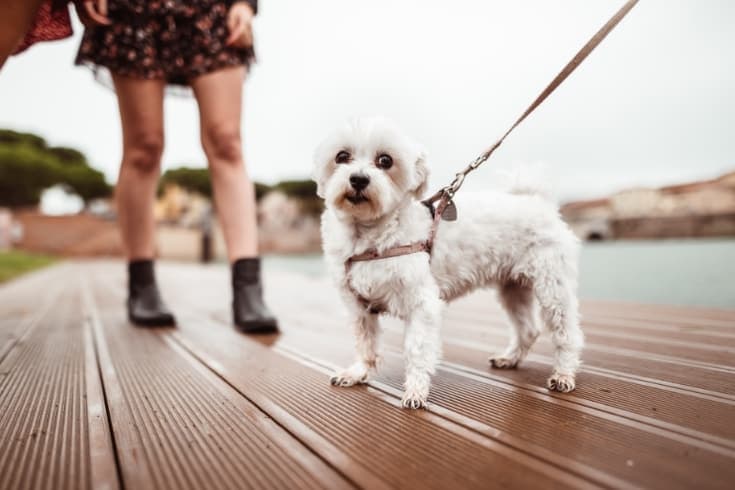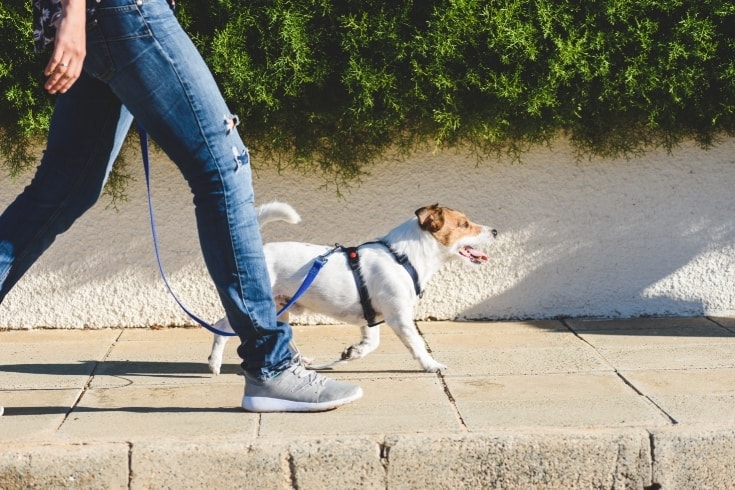Many people use the terms lead and leash interchangeably. But are the two the same?
Essentially, a leash and a lead are the same things when used by dog owners to refer to the rope or leather cord that attaches to their dog’s harness or collar.
However, there are a few subtle differences between the two terms.
Read this guide on lead vs. leash to learn the differences between the two.
Lead vs. Leash

There are a few differences between the meaning of the words lead and leash.
The Meaning for Dog Owners
For dog owners, a lead or a leash is the ropelike cord that’s used as an umbilical cord between the dog and its handler.
The terms lead and leash are used pretty much interchangeably and have the same basic meaning.
A leash can be made from nylon, rope, leather, or thin cord in the case of retractable leashes. Leashes and leads can be of different lengths, ranging from a 2-foot traffic leash to a 26-foot retractable leash.
That said, the word “leash” is both a noun and a verb used for dogs and cats. However, “lead” is more commonly used for horses and other animals.
A Leash
The Oxford dictionary defines a leash as “a dog’s lead.”
The term “leash” implies that the dog is tied up or fixed to its handler. So, as the dog’s owner walks through the park, the dog is fixed to them so that it doesn’t run off.
A Lead

The word “lead” is defined in the dictionary as:
“to cause (a person or animal) to go with one by holding them by the hand, a halter, a rope, etc., while moving forward.“
So, the dog’s handler is regarded as giving the dog a lead and expecting the pup to follow.
Horses for Courses
In the case of horses, a handler uses a “lead rope” or “lead rein” to take the horse wherever they need the horse to be. The term “leash” is not used when referring to horses.
Language Barriers
In the UK, most dog owners refer to having their dog in a lead. The terms “on leash” and “off leash” are generally used in the US and Canada. But in Australia, a dog is said to be on a lead, although the country has leash laws stating that off-leash dogs are not permitted in many areas.
So, the terms leash and lead are used differently, depending on where you are in the world. However, the American difference in terminology is unlikely to cause much confusion among dog lovers.
FAQs
Here are a few dog owners’ most frequently asked simple questions about leashes, leads, and the differences between them.
Q: What is the difference between a training leash and a regular leash?

A: Training leashes come in different lengths, depending on what training you intend to do with your canine companion. A regular leash is typically 6 feet long and fixes to your dog’s harness or collar via a spring clip at one end of the leash.
Slip-training leashes are also called soft leashes. The leash comes tight around your dog’s neck if he pulls. But as soon as the dog stops pulling, the leash comes loose. So, the main leash difference is that you can use a training leash to teach a dog not to pull.
Don’t confuse training leashes with training collars. Training collars can be prong collars, choke collars, electronic collars, and martingale collars. These collars work by inflicting pain on the dog when he pulls or lunges.
I do not recommend the use of training collars. You want your dog to develop trust and obedience through positive reinforcement and reward-based training methods. If your dog associates being on his leash with pain, he might become afraid of you and fearful of being taken for a walk.
Q: Why do people call a leash a lead?

A: Some people call a leash a lead, although the two are essentially the same thing.
Q: Is it OK to walk a dog on a lead?
A: Most US states have strict leash laws that mean you must always walk your dog on a lead unless you’re in a dog park where off-leash exercise is permitted.
Provided your dog is leash trained and will walk obediently at your side on his leash, he can enjoy exercise on a leash. Leashes come in different weights and lengths to suit your dog’s age and size.
Q: Should a dog be kept on a lead?
A: If you live in a state with strict leash laws, you’ll need to have your dog on a leash unless you’re in a dog park or other designated off-leash area.
Leashes are usually obligatory for public safety. If you’re walking in a busy area, entering a store, or attending the vet clinic, you must have your dog on a regular or short training leash.

In wilderness areas or rural localities where livestock are at large, you should keep your dog leashed so that he can’t chase anything. Exceptions to that rule are usually applicable to farm or hunting dogs that are working when supervised by a handler and with the land owner’s permission.
Leash laws vary between countries, too. For example, we don’t have strict leash laws here in the UK. As long as you have your dog under control, you don’t need to keep him leashed unless there are notices to the contrary in the area you’re walking your furry friend.
Final Thoughts
I hope you enjoyed our guide to the differences between lead and leash. If you did, please take a moment to share the article!
Essentially, the words leash and lead mean the same thing with a few subtle differences. For example, here in the UK, we use the word lead rather than leash, although the two actually mean the same thing.
Where do you live? What do you call your dog’s leash or lead? Just for fun, why not tell us in the comments box below?
